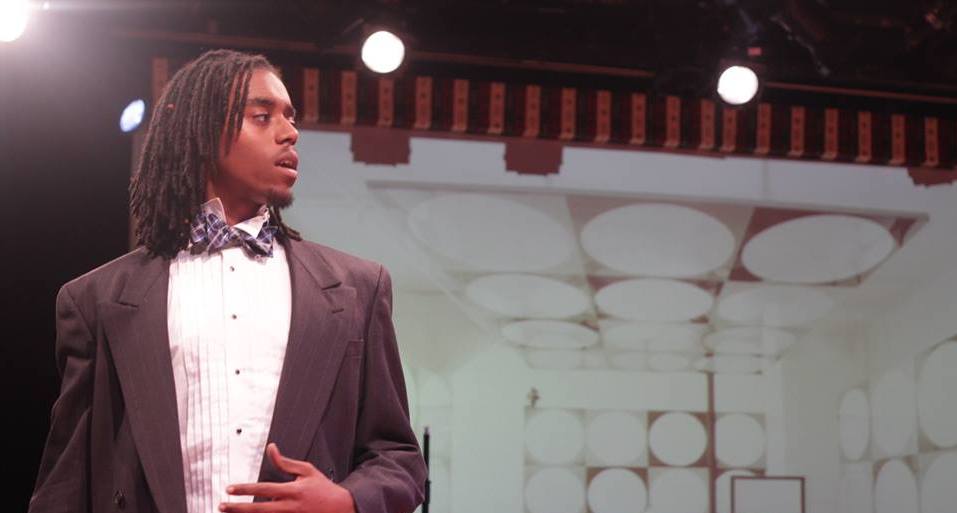As the audience filtered into the Rutgers-Newark theater on Thursday night, students and parents alike chose their seats for “The Colored Museum” with care. The audience members chattered curiously about the pairs of black shackles that lined the backs of the theater chairs, a sight that certainly gave me pause. Surely the play wouldn’t be interactive, I thought, as I took a seat in the middle of the center section with a friend. As the audience settled into their seats, music played in the background and a PowerPoint slideshow was projected onto the stage, showing images of famous African-Americans. Then, as the previously Top 40 playlist changed into the intense sounds of tribal drumming, the lights dimmed in the small, intimate theater, and the show began.
Sketch I: Aboard the Airborne Slave Ship
There was nothing subtle in the first scene of the play, as two overly cheerful stewardesses welcomed us aboard the Celebrity Slave Ship, reminding us to keep our shackles on at all times throughout the flight. The contrast of their smiles with the reality of slavery was startling, and at first it seemed as if the audience wasn’t sure if laughter would be appropriate. But despite initial discomfort, the audience was soon howling with laughter as the stewardesses guided us during the flight, which included a highly satirical history lesson, to our final destination.
Sketch II: Cooking with Aunt Ethel
A quick scene change had the audience staring at a modern kitchen, in the center of which stood an island-style cabinet with an out-of-place-looking cauldron. We were welcomed onto the “Cooking with Aunt Ethel Show” by Aunt Ethel herself, who promptly broke into song, sharing with us a recipe that included “a pinch of style…a dash of flair…[add] a box of blues.” As the young actress threw the imaginary ingredients into the cauldron, she sang, “…Add some attitude. Oops! I put too much!” and NJIT/Rutgers students alike laughed. As the recipe drew to an end, Aunt Ethel declared, much to the amusement and shock of the intrigued audience, that she had just shared the recipe for a “batch of negroes.”
Sketch III: Beautiful
The third act took place in a photo studio, where two characters, a male and a female model, posed and shared their thoughts on the current focus on beauty. As hidden cameras kept shooting their photos, the two spoke of the “beautiful yet not profound world we live in [nowadays].” The piece was edgy and flirty, and, because their words spoke of such truths, somewhat saddening.
Sketch IV: The Soldier Plays God
The background changed, to show a jungle, as heavy mist rolled out towards the audience. “Psst,” a soldier’s monologue began, and he spoke of his own death, of how he had died but had come back for some unknown purpose. His fellow soldiers lay prone in the shadows, and as he spoke, they became animated, saluting their fallen comrade (the main character). As they rose, the main character said he could see “a piece of their future [suffering], right there on their face.” To save them from these future pains, he gradually killed them in their sleep, narrating that he was injecting oxygen into their veins one by one.
Sketch V: Ms. Raj
The fifth act brought my favorite scene (which, coincidentally, was also Johnson’s favorite), featuring Ms. Raj, a self-declared transvestite male wearing a risqué, sparkly gown. He spoke of the difficulties he’d faced, living as he did, and the power he gained from overcoming the judgmental stares and jeers from the general public. To a chorus of laughter, he declared, “God created black people. And black people created style,” and went on to snap his fingers, which went hand-in-hand with his title, “The Snap Queen.”
Sketch VI: Talking Heads
The scene transformed into a bedroom, in which a woman with her head wrapped in a towel sat at her make-up table. As she diligently applied cosmetics with her back to the audience, and her face was projected onto the screen using a GoPro hidden beside her mirror. Suddenly, the two “wigs” that were across the room broke into animated chatter, discussing wigs and “modern” hairstyles and gossiping about the woman’s date. The scene culminated in a heated and hilarious debate about which wig would be chosen for that night’s outfit, as the poor woman doing her make-up nearly fainted with fright at the talking heads.
Sketch VII:
The skit that Johnson said he’d had the most difficulty directing was titled, “Last Mama on the Couch,” and was based on the premise that the scene was a play featuring a mother, her son and his wife, and her daughter in their living room that was being rehearsed. As the “director” of this play within a play ran about, narrating the happenings, each character had a short monologue during which they shared their woes. In a sudden turn of events, the brother gets shot by the police as he sticks his head out the window, and the remaining cast members burst into song, lamenting his death and asking God why he couldn’t have been born in a different time, where he could have had the chance to dance. The unexpected highlight of the scene was when, just after the son was shot and as the mother mourned his death, the innocent voice of a child in the audience whispered in shock, “What happened?!”
Sketch VIII: Symbiosis
The message of this scene was particularly clear. Its cast was made up of a young man in a fancy suit and his older self, wearing ragged street clothes, who was beseeching his current self to not throw all of their sentimental items into the dumpster. But the “reformed self” said he had to get rid of that which “makes him black.” He explains to his older self that the world is undergoing a climate change, and unless they change with it, they’ll end up a sociological dinosaur, extinct. And so the reformed self is erasing their old life, claiming, “I have no history…I can’t…I can be black on the weekends.” After a scuffle, the reformed self throws his older self in the dumpster and walks off with their old record, humming their old favorite song, “My Girl,” as the audience sings along.
Sketch IX: Lala – The Lamazing Grace
This scene was the longest and most confusing, for both myself and my companion. The scene was partly a musical, and featured the slightly-famous singer, Lala, her sponsor, Florence, and her assistant who was “not too clever.” The performer had gone to Europe to become famous, and had ended up changing herself completely: the old her had had to die so the new star, “Lala,” could be born.
Sketch X: Fruit Salad
A seemingly mentally disabled young woman walked onto the stage, cradling an enormous white egg, and began her monologue, in which she explained that she’d “[screwed] the garbage man,” which was, “like having sex with a fruit salad…except [she] didn’t spit out the seeds.” And as such, she became pregnant, symbolized by the egg. The scene was humorous yet strange, and utterly confusing. The Honors Talk-Back Session at the end of the play helped clear it up: the director explained that the most important thing to take away from the play was that, when such a pregnancy occurs, people ought not to condemn the child for the mother’s actions.
Sketch XI:
The entire 16 member cast came on stage, in costume, and stood chatting in the background as one actress spoke of the trials and tribulations of being African-American, and then the cast broke into a medley of the key quotes from their individual scenes. The chaotic scene culminated in the famous quote, “My power is in my colored contradictions.”
In the after-show NJIT Honors College Talk-Back session, cast members answered questions from the audience, and the actors and actresses shared their feelings on the play, admitting that, at first, they too had been confused by some of the scenes. But with time they’d come to understand the play as it was intended: to show that profiling and stereotyping is wrong, and that we should not allow others to judge us, and, as Johnson said, “we should just be who we wanna be.”


























